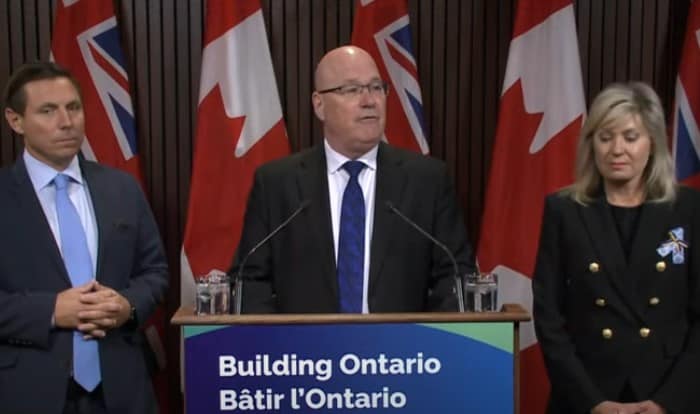‘Financial ramifications’ of Brampton leaving Peel could be up to $4 billion: Mayor Brown
Published May 18, 2023 at 2:35 pm

Mayor Patrick Brown says there’s a $4-billion question mark hovering over the decision for Brampton to officially stand on its own two feet as the province does away with the Region of Peel.
The province tabled the legislation to start the dissolution process today (May 18) putting an end to months of speculation following an announcement earlier this year that Ontario was planning a review of regional governments.
Known as the Hazel McCallion Act, the legislation is the first step towards transitioning Brampton, Mississauga and Caledon into independent, single-tier municipalities with no regional oversight.
And while the move is being welcomed by Brampton Mayor Patrick Brown and his Mississauga counterpart Bonnie Crombie, Brown says there’s a potential $4 billion bill coming due for water and wastewater facilities that lie in Mississauga’s borders.
“The rhetoric coming out of Mississauga is alarming, and we hope that the province will reiterate to the City of Mississauga that there’s no running out, there’s no dine and dash permitted when it comes to regional infrastructure,” Brown said on Thursday.
Brown said initial estimates for Brampton to build its own water treatment and wastewater facilities would be “$1 billion and $3 billion, respectively.”
“That’s 4 billion. We’d expect a cost contribution from Mississauga like we did for the facilities in Mississauga,” Brown said.
But whether those projects would be needed remains to be seen, as the province has yet to form a Transition Board that will oversee the break up of Brampton, Mississauga and Caledon.
Brown added that should water services facilities need to be replaced that equals out to approximately “$600,000 per resident.”
Brown and Crombie have squared off in the media in recent days over what will happen to shared infrastructure and services – the Peel Regional Police headquarters and the region’s water and wastewater facilities are in Mississauga, while Brampton has the waste disposal plant and the Peel Paramedics HQ.
While Brown again rang the alarm bells on Thursday, Crombie said she’s confident that many of the region’s shared services can be transitioned into a user-pay utility.
And despite the sparring between Brown and Crombie, Mayor Annette Groves of Caledon says she has confidence that the province won’t leave any of the three municipalities without critical services.
Premier Doug Ford has repeatedly said that Brampton will be “made whole” in the divorce, but Brown says comments from Crombie to the contrary have been “alarming.”
The Region of Peel was formed in 1974 under then-Premier and Brampton’s own Bill Davis, and comprises Mississauga, Brampton and Caledon. The three municipalities share services Peel Paramedic Services, garbage collection and recycling, water and water treatment, road maintenance and much more, including Peel Regional Police in Brampton and Mississauga.
The legislation sets out plans to fully dissolve the regional government by Jan. 1, 2025, starting with Thursday’s announcement and the formation of a “Transition Board” later this year with a goal of finding “an amicable and fair dissolution process that respects taxpayers and protects existing services,” the province says.
The Transition Board will be appointed by the Minister of Municipal Affairs and Housing and is expected to make its final recommendations to the province in the second half of 2024, with further legislation planned to “address any outstanding restructuring matters.”
“The dissolution process, with the support of the transition board, would help ensure a fair outcome for the three municipalities that prioritizes the preservation of frontline services and workers, respect for taxpayers and government efficiency,” the province said.
Clark said he expects the governments of all three municipalities to work together with the board to find collaborative solutions during the transition.
McCallion, the former mayor of Mississauga who died earlier this year, long pushed for that city’s independence from the region and Steve Clark, Minister of Municipal Affairs and Housing is a nod to her legacy.
The province said plans for population growth and meeting housing targets were the main factors behind the split, but with a long transition process ahead there are many questions about what will happen to infrastructure and services currently shared by the three municipalities.
The population of the region is expected to grow from 1.5 million to two million people by 2041, and the province has set aggressive housing targets to meet demand.
Eliminating the upper-tier government is expected to speed up development approvals for housing, and the separation will mean the municipalities “have the tools and autonomy they need to deliver on local priorities.”
Peel is the first upper-tier government to see big changes but Durham, Halton, Niagara, Simcoe, Waterloo, and York will all see the province name regional facilitators in the coming weeks to determine if “the upper-tier regional government continues to be relevant…or whether the lower-tier municipalities are mature enough to pursue dissolution.”
INsauga's Editorial Standards and Policies








